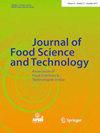Optimization of thermal treatments of cold vegetables soups from Spain to preserve their quality, bioactivity and phytochemical composition
IF 3.3
3区 农林科学
Q2 FOOD SCIENCE & TECHNOLOGY
引用次数: 0
Abstract
The aim of this work was to determine the effect of different heat treatments ( 1) 90oC and cooled down immediately to a final temperature of 30oC, 2) 90oC during 15s. and immediately cooled down to a final temperature of 30oC, and 3) commercial treatment) on the colour, pH, total soluble solids, antioxidant capacity, and phenolic compounds of three different vegetal food products: 1.carrot, orange and coriander soup (COS); 2.gazpacho (typical Spanish vegetable soup made mainly with tomato, pepper, cucumber, olive oil, vinegar and garlic (GAZ); and 3.tomato, mint and basil soup (TMS). The results showed that the mentioned parameters were influenced by the heat treatments studied in, depending on the temperature and time of each one, and the different products which were applied. COS and TMB showed the highest antioxidant capacity values in their respective commercial samples. However, GAZ treated at 90oC and 90oC/15s. kept the same antioxidant capacity levels that the tank sample (untreated). The colour, pH and total soluble solids parameters remained practically without significant changes produced by the different heat treatments applied, demonstrating that the applied treatments can be more effective than commercial in order to preserve shelf life of these products, and keeping the majority of their crucial properties in these kinds of foods. For that, the results here presented are of significant interest for agro-food industry.西班牙冷菜汤的热处理优化,以保持其品质、生物活性和植物化学成分
这项工作的目的是确定不同热处理的效果(1)90℃,并立即冷却到最终温度30℃,2)90℃,在15秒内。并立即冷却至30℃的最终温度,以及3)商业处理)对三种不同植物食品的颜色,pH值,总可溶性固体,抗氧化能力和酚类化合物的影响:胡萝卜橙香菜汤(COS);2.西班牙凉菜汤(gazpacho)(典型的西班牙蔬菜汤,主要用番茄、胡椒、黄瓜、橄榄油、醋和大蒜做成);和3。番茄薄荷罗勒汤。结果表明,上述参数受到所研究的热处理的影响,取决于每种热处理的温度和时间,以及所应用的不同产品。COS和TMB在各自的商业样品中表现出最高的抗氧化能力值。然而,GAZ在90oC和90oC/15s下处理。保持与槽样相同的抗氧化能力水平(未经处理)。颜色、pH值和总可溶性固形物参数几乎没有因不同的热处理而产生明显的变化,这表明,为了保持这些产品的保质期,在这些食品中,所采用的热处理可以比商业处理更有效,并保持它们的大多数关键特性。因此,本文提出的结果对农业食品工业具有重要意义。
本文章由计算机程序翻译,如有差异,请以英文原文为准。
求助全文
约1分钟内获得全文
求助全文
来源期刊
CiteScore
7.70
自引率
0.00%
发文量
274
审稿时长
11 months
期刊介绍:
The Journal of Food Science and Technology (JFST) is the official publication of the Association of Food Scientists and Technologists of India (AFSTI). This monthly publishes peer-reviewed research papers and reviews in all branches of science, technology, packaging and engineering of foods and food products. Special emphasis is given to fundamental and applied research findings that have potential for enhancing product quality, extend shelf life of fresh and processed food products and improve process efficiency. Critical reviews on new perspectives in food handling and processing, innovative and emerging technologies and trends and future research in food products and food industry byproducts are also welcome. The journal also publishes book reviews relevant to all aspects of food science, technology and engineering.

 求助内容:
求助内容: 应助结果提醒方式:
应助结果提醒方式:


